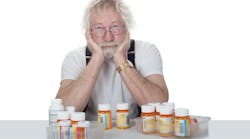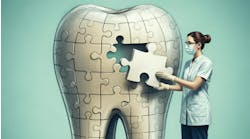Me: “I see you’re taking medications but didn’t list them. Can you tell me what they are?”
Patient: “I did. See, they’re on the lines. Big circle, small circle, and oval. Not sure of their names or what they’re for, but you can figure it out, right?” (figure 1).
I did a double take and, indeed, the patient had written down his meds. And of course I could tell you the names of them. Duh!
Me: “Are you taking controlled substances?”
Patient: “Yes, a beer a day, and it works great.”
Okaaaaaay . . .
Patient: “My tooth has been hurting for a while and I had some leftover pain meds, so I’ve been taking those to help. Can I get more?”
My thoughts: “Where are the pain meds from, and how old are they?”
My favorite is when there is a typed list of medications that fills an entire page and the patient says, “My doctor prescribed them and told me to take them. I’m not sure what they’re all for, but at least I’m compliant.” Interesting.
With that introduction, let’s talk about drugs. Let’s have a candid discussion about a subject many of us aren’t willing to have and lay it all out on the line. Why is this topic taboo? Why do we dance around it? Is it because we don’t want to consider the possibility that we may be prescriber-happy doctors, or for that matter, maybe we have a prescriber-happy profession?
Compared to our general practice/surgeon counterparts, the scope of our clinical practice inherently limits the need for the broad spectrum of prescriptions given, but there is a trend suggesting that when patients go to a doctor, they want their problems fixed now, and when they can’t be fixed now, drugs can take care of the problem. Our dental patients definitely fall into this category.
Why is that? Well, because it’s easier to write a script to manage an issue than it is to actually work toward fixing the underlying etiology. How about high blood pressure, cholesterol, and borderline diabetes? Well, diet and exercise are just too difficult, so popping a few pills will surely quell the concern. Easy-peasy.
Here’s the problem and a scary trend: over 73% of doctor visits result in some kind of prescription.1 Wow. Just wow. These are the patients who have those laundry lists of overlapping medications, which often cancel each other out. We’ve all seen those lists.
Let’s drive home the point in dentistry. A limited-exam patient comes in with an abscessed tooth. The doctor writes a prescription of antibiotics, perhaps a few pain meds, and schedules the patient to have the tooth pulled. Totally legit. Well, well, well . . . wouldn’t you know it? The swelling and pain get better and guess what, the patient cancels the appointment.
So, the questions become, “What do we do when the patient calls again because—surprise—the area around the tooth is swollen again? Do we charge for a new exam, prescribe more drugs, and pull the tooth? Well, yes! Are we enabling patients and not enforcing action on their part? There truly isn’t a right or wrong answer to these questions. But to play devil’s advocate, we are doing our part, but it is not our responsibility to babysit patients for things they need to take the reins on.
I had a recent discussion with a colleague pharmacist/educator/worldwide lecturer who shared a conversation with me where he talked to a group of dentists about the overabundance of script writing, specifically narcotics. This is indeed an issue in our profession. Afterward, he was approached by a dentist who more or less told him he agreed with what was said, but he was not going to change his script practices because he didn’t want to deal with the potential for late-night calls or other issues.
I have many thoughts on this, all of which center around the efficacy and ability (or lack thereof) that we have as dental providers to educate and manage our patients. Maybe this is where the discussion really needs to start. As I said earlier, its muuuch easier to give out drugs (and I say that facetiously).
I wanted to get an idea of where I stand with my prescriber statistics for this year. Here are my stats. (This is something you should do as well.)
• Number of patients seen: 2,394
• Number of antibiotic scripts: 97
• Number of pain/narcotic scripts: 28
• Other (fluoride, various miscellaneous scripts): 18
In other words, approximately 6% of my patients this year received some kind of script. I do quite a bit of surgery and will infrequently prescribe narcotics. When I do, I very rarely give more than 10. If the patient needs more, then he or she must see me again, because in all reality, over-the-counter meds can and do vanquish more pain than we give them credit for! True, depending on the type of dentistry you do, the number of pills definitely varies, but I will submit that to some degree, patients expect to be medicated and are almost surprised when you tell them it’s not always necessary. We have to retrain their frame of mind.
On the flip side, there are those patients who don’t want any medication at all, even when they really and truly need it. They tend to rely on various oils and home remedies to cure everything, because “If you put Vitamin C directly over the swollen part of the gums of an abscessed tooth, it will take the infection away.” Don’t get me wrong—there is definitely a place for natural remedies, but modern medicine works for a reason and it’s all about finding balance.
Just to be clear—I am a believer in medicine and understand that the benefits of these drugs are for the patient’s well-being. It is not my place to question or contradict another provider’s prescribing practices. However, I do believe that when patients don’t understand or know why they are taking the medications they’ve been prescribed, perhaps things should be reevaluated for the sake of the patient...and perhaps that provider should slow down with the script pad. Our intentions may be sound, but I’m confident that our execution of said intentions could warrant modification, myself included.
In case you’re wondering what medications the small circle, big circle, and oval-shaped pills were, it turns out they were blood pressure meds, cholesterol meds, and an 81 mg aspirin tablet. It’s all about the shape, my friends! And I daresay that many would agree with the beer-a-day therapy too!
Cheers to our many dental adventures.
Reference
1. Therapeutic drug use. National Center for Health Statistics. Centers for Disease Control and Prevention website. https://www.cdc.gov/nchs/fastats/drug-use-therapeutic.htm. Updated January 19, 2017. Accessed October 8, 2019.
Editor’s note: This article originally appeared in Breakthrough Clinical, a clinical specialties newsletter from Dental Economics and DentistryIQ. For more information or to subscribe, visit dentistryiq.com/subscribe.
Stacey L. Gividen, DDS, a graduate of Marquette University School of Dentistry, is in private practice in Hamilton, Montana. She is a guest lecturer at the University of Montana in the Anatomy and Physiology Department. Dr. Gividen is the editorial director of Endeavor Business Media’s clinical dental specialties e-newsletter, Breakthrough Clinical, and a contributing author for DentistryIQ, Perio-Implant Advisory, and Dental Economics. She also serves on the Dental Economics editorial advisory board. You may contact her at sgividendds@gmail.com.









